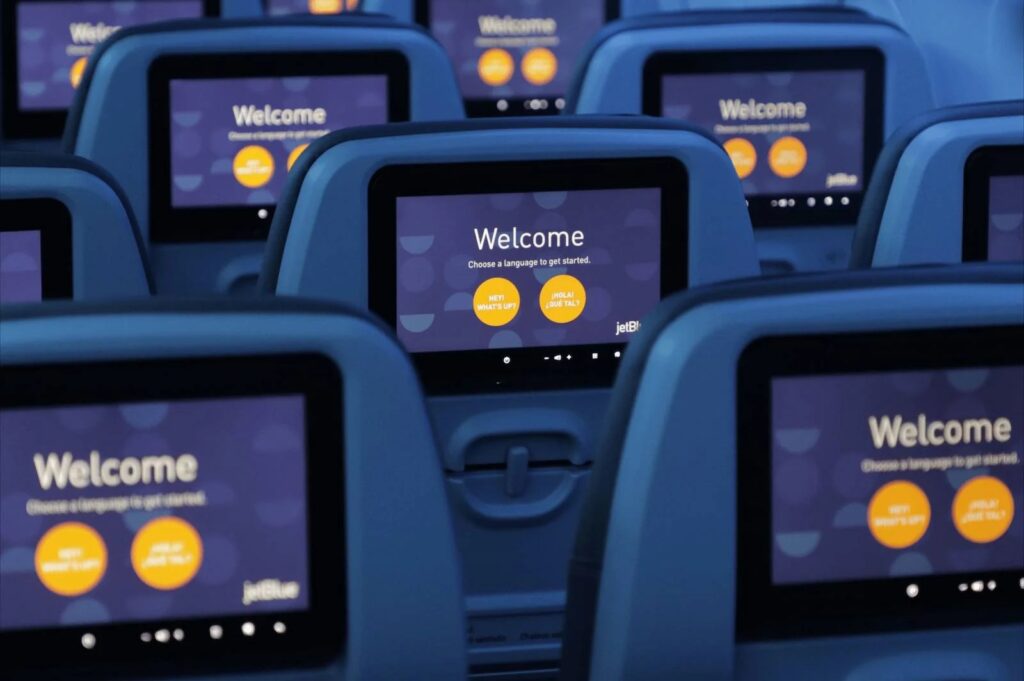Exploring the Evolution of In-Flight Wi-Fi at SXSW: Insights from JetBlue and Viasat
Share
At this year’s South by Southwest (SXSW) conference, a panel discussion featuring Mariya Stoyanova, Director of Product Development at JetBlue, and Edwin Edillon Jr., Product & Partnerships leader from Viasat, shed light on the evolving landscape of in-flight Wi-Fi and its impact on the passenger experience. The conversation delved into the challenges, innovations, and future prospects of keeping travellers connected at 35,000 feet.

(Image via JetBlue)
JetBlue made a bold move a decade ago by partnering with Viasat to offer free, high-speed Wi-Fi to its passengers, starting on one aircraft in 2013 and a full roll-out in 2017. Stoyanova explained, “We decided that we’re going to skip the first wave. And we’re going to find a partner in crime who is, in a way, the same type of crazy as we are. And we wanted to challenge the status quo and…provide our customers with a product that works.”
This decision set a new standard for in-flight connectivity, according to Stoyanova. However, providing reliable, high-quality internet on planes is no simple task. Factors such as high usage density, aircraft movement, and hardware limitations pose significant hurdles that require constant innovation and optimisation.
Edillon highlighted the complexity of delivering Wi-Fi on planes, stating, “What a lot of people don’t realise is getting internet on a plane requires a substantial amount of physical hardware. that goes on a plane, it’s the antenna, then there’s typically a dome covering the antenna, and there are servers on the inside. And all of that allows the multiple number of devices on the aircraft to connect to a wireless access point and get internet. All the bits and bytes go over the antenna through the satellite and back to the ground.”
As passenger behaviour has shifted towards a growing demand for streaming video content, JetBlue and Viasat have had to adapt to keep pace. By employing advanced technologies like edge caching and developing more efficient content delivery methods, they’ve managed to stay ahead of the curve. The result is a Wi-Fi experience that meets passengers’ expectations and opens up new opportunities for engagement and partnerships.
One notable example is JetBlue’s collaboration with Amazon, which has allowed the airline to monetize its free Wi-Fi offering while providing passengers access to a wide range of content and services. This partnership showcases how in-flight connectivity can serve as a platform for brands to connect with captive audiences in meaningful ways. Looking ahead, JetBlue aims to further personalize the in-flight experience by leveraging loyalty programs and customer data, creating tailored experiences that cater to individual preferences.
Edillon also highlighted the potential of in-flight Wi-Fi, stating, “I’d love to see it become cost-neutral to the point where, you know, the airlines can focus their resources on other amenities. And we’ve brought enough third-party value that they can come and say, You know what, we want that Wi-Fi to be for our passenger.”
However, the future of in-flight Wi-Fi extends beyond just providing access to content. JetBlue envisions a seamless, frictionless experience where passengers’ devices automatically connect to the onboard network, eliminating the need for cumbersome login processes. This level of convenience will allow travellers to focus on enjoying their flight while opening up new avenues for engagement and interaction.
To achieve this vision, the panel discussed how JetBlue and Viasat continually push the boundaries of what’s possible. By prioritising elements of the customer experience based on research and observing unmet needs, they can innovate in ways that resonate with passengers.
As Stoyanova noted, “A lot of our products are coming just from us observing how customers behave on board and identifying unmet needs that even they’re not fully consciously aware of, and designing for, for those needs anticipating them.” This approach has allowed JetBlue to continue innovating despite not having the same resources as some of its larger competitors.


